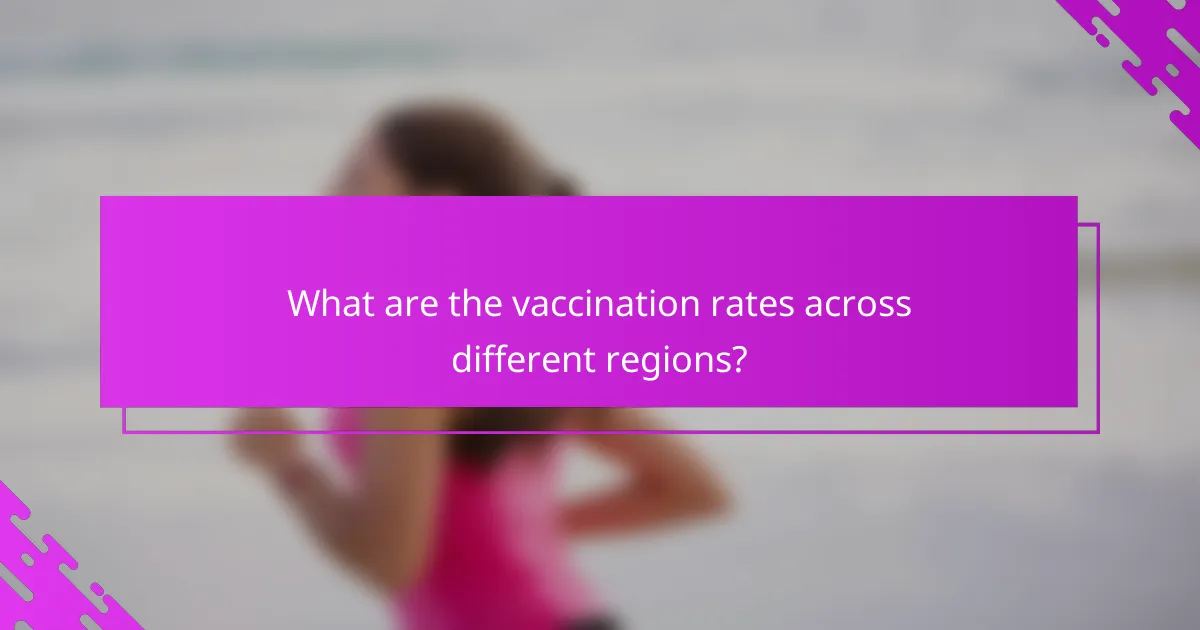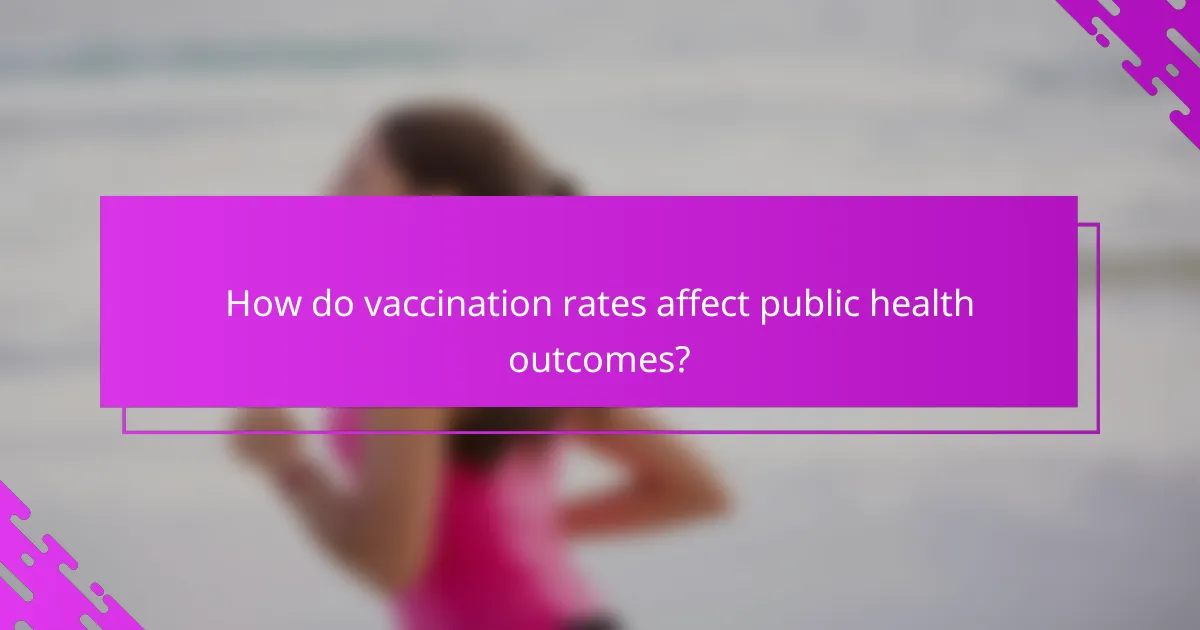Vaccination rates exhibit considerable regional variations influenced by factors such as healthcare access, public policy, and cultural attitudes. Recognizing these differences is essential for effectively addressing public health challenges and enhancing vaccination coverage worldwide.

What are the vaccination rates across different regions?
Vaccination rates vary significantly across different regions due to factors such as healthcare access, public policy, and cultural attitudes. Understanding these variations is crucial for addressing public health challenges and improving vaccination coverage globally.
North America vaccination rates
In North America, vaccination rates are generally high, particularly for childhood vaccines. The Centers for Disease Control and Prevention (CDC) reports that routine childhood vaccination coverage often exceeds 90% in many states.
However, disparities exist, with some areas experiencing lower rates due to vaccine hesitancy or access issues. Public health initiatives continue to focus on increasing awareness and accessibility to improve these figures.
Europe vaccination rates
Europe shows a mixed landscape in vaccination rates, with many Western European countries achieving high coverage levels, often above 85%. Countries like Spain and Portugal have implemented successful campaigns to maintain high immunization rates.
Conversely, some Eastern European nations face challenges, with rates sometimes dipping below 70%. Efforts are underway to address misinformation and enhance public trust in vaccines.
Asia vaccination rates
Asia’s vaccination rates vary widely, with countries like Japan and South Korea reporting high coverage, often exceeding 90%. In contrast, regions with limited healthcare infrastructure, such as parts of South Asia, may struggle to reach similar levels.
Government initiatives and international aid play a vital role in improving vaccination access and education in lower-income areas, aiming to increase overall rates significantly.
Africa vaccination rates
Africa faces significant challenges in vaccination rates, with many countries reporting coverage below 70%. Factors such as logistical issues, healthcare access, and public awareness contribute to these low figures.
International organizations are actively working to improve vaccination rates through programs that provide vaccines and educate communities about their importance. These efforts are crucial for combating preventable diseases across the continent.
Oceania vaccination rates
In Oceania, vaccination rates are generally high, particularly in Australia and New Zealand, where coverage often exceeds 90%. These countries have robust healthcare systems and effective public health campaigns.
However, some Pacific Island nations may experience lower rates due to geographical challenges and limited resources. Targeted initiatives are essential to ensure that all regions achieve adequate vaccination coverage.

How do vaccination rates vary by demographic factors?
Vaccination rates differ significantly across various demographic factors, including age, gender, and socioeconomic status. Understanding these variations can help target public health initiatives more effectively.
Age group vaccination trends
Vaccination rates typically show notable differences across age groups. For instance, children often have higher vaccination rates due to school requirements, while older adults may have varying rates influenced by health concerns and access to healthcare.
In many regions, adolescents and young adults may exhibit lower vaccination rates, particularly for newer vaccines. Public health campaigns aimed at these age groups can help improve uptake.
Gender differences in vaccination
Gender can influence vaccination rates, with studies indicating that women often have higher vaccination rates than men. This trend may be attributed to women being more proactive about health and wellness, as well as higher engagement in healthcare services.
However, specific vaccines may show different patterns; for example, men may be more likely to receive certain vaccinations related to occupational health. Tailoring communication strategies to address these differences can enhance vaccination efforts.
Socioeconomic status impact
Socioeconomic status significantly affects vaccination rates, with lower-income individuals often facing barriers such as cost, access to healthcare, and education about vaccines. These factors can lead to lower vaccination rates in economically disadvantaged communities.
Efforts to increase vaccination rates in these populations may include providing free or subsidized vaccines, improving access to healthcare facilities, and conducting community outreach programs to raise awareness about the importance of vaccinations.

What are the key factors influencing vaccination rates?
Vaccination rates are influenced by a combination of access to healthcare services, public health policies, and community awareness and education. Understanding these factors can help identify barriers and improve vaccination coverage in different regions.
Access to healthcare services
Access to healthcare services plays a crucial role in vaccination rates. Areas with well-established healthcare facilities and a sufficient number of healthcare professionals tend to have higher vaccination uptake. Conversely, regions with limited access, such as rural or underserved urban areas, often see lower rates.
Transportation availability, clinic hours, and affordability of services also impact access. For example, if vaccination clinics are only open during working hours, working individuals may struggle to get vaccinated, leading to lower overall rates.
Public health policies
Public health policies significantly influence vaccination rates through mandates, funding, and outreach programs. Countries or regions that implement mandatory vaccination laws often see higher compliance rates. For instance, schools may require vaccinations for enrollment, which can drive up overall community immunization levels.
Additionally, government funding for vaccination programs can enhance accessibility, especially in low-income areas. Effective policies that promote free or subsidized vaccines can remove financial barriers and encourage higher participation.
Community awareness and education
Community awareness and education are vital for increasing vaccination rates. Public health campaigns that inform residents about the benefits and safety of vaccines can help dispel myths and misconceptions. Engaging local leaders and influencers can also enhance trust and encourage community participation.
Educational initiatives should be tailored to the specific needs and concerns of the community. For example, providing information in multiple languages or addressing cultural beliefs can improve understanding and acceptance of vaccinations, ultimately leading to higher rates.

How do vaccination rates affect public health outcomes?
Vaccination rates significantly influence public health outcomes by determining the prevalence of infectious diseases and the overall health of a population. Higher vaccination rates generally lead to lower disease incidence, reduced healthcare costs, and improved long-term health benefits.
Impact on disease prevalence
Vaccination rates directly affect the prevalence of infectious diseases within a community. When a significant portion of the population is vaccinated, herd immunity is achieved, which protects those who cannot be vaccinated due to medical reasons. For example, high vaccination rates against measles can prevent outbreaks and protect vulnerable groups.
Conversely, low vaccination rates can lead to increased disease outbreaks, as seen in regions with vaccine hesitancy. Communities with vaccination rates below recommended thresholds often experience spikes in diseases that were previously under control.
Healthcare costs associated with vaccination
Investing in vaccinations can lead to substantial healthcare savings by preventing disease outbreaks and reducing hospitalizations. The costs associated with treating vaccine-preventable diseases can be significantly higher than the costs of vaccination programs. For instance, a single hospitalization for a preventable disease can exceed thousands of dollars, while vaccines typically cost much less.
Moreover, public health initiatives that promote vaccination can help reduce the overall burden on healthcare systems, allowing resources to be allocated more effectively. This can lead to lower insurance premiums and out-of-pocket costs for individuals.
Long-term health benefits
Vaccination not only prevents immediate disease but also contributes to long-term health benefits for individuals and communities. Vaccines can reduce the risk of chronic health issues that may arise from infections, such as heart disease or neurological disorders. Over time, populations with high vaccination rates tend to have better overall health outcomes.
Additionally, maintaining high vaccination coverage can lead to the eradication of certain diseases, as seen with smallpox. This not only saves lives but also frees up healthcare resources for other pressing health issues, ultimately enhancing the quality of life for future generations.

What are the trends in vaccination rates over the last decade?
Over the last decade, vaccination rates have shown significant variability across different regions, influenced by factors such as public health policies, access to healthcare, and community attitudes. Many countries have experienced an overall increase in vaccination coverage, but disparities remain, particularly in low-income areas.
Regional Variations in Vaccination Rates
Vaccination rates can differ dramatically between regions due to socioeconomic factors, healthcare infrastructure, and cultural beliefs. For instance, urban areas often report higher vaccination rates compared to rural regions, where access to clinics may be limited. In some countries, vaccination rates can range from low single digits in certain communities to over 90% in others.
In Europe, for example, countries like Portugal and Spain have achieved high vaccination coverage, while others face challenges with vaccine hesitancy. Similarly, in the United States, states such as Vermont and Massachusetts report higher rates compared to states with more resistance to vaccination.
Factors Influencing Vaccination Trends
Several factors influence vaccination trends, including public health initiatives, education campaigns, and the availability of vaccines. Effective communication from health authorities can significantly increase public trust and uptake. Conversely, misinformation can lead to hesitancy and lower vaccination rates.
Economic factors also play a role; regions with better healthcare funding tend to have higher vaccination rates. For instance, countries with universal healthcare systems often report better vaccination coverage compared to those where healthcare is primarily private.
Future Trends and Predictions
Looking ahead, vaccination rates are expected to evolve with advancements in vaccine technology and changes in public health policies. The introduction of new vaccines and booster programs may further impact coverage rates. Additionally, ongoing efforts to combat misinformation are crucial for maintaining and improving vaccination uptake.
Public health experts predict that as awareness grows and accessibility improves, vaccination rates may stabilize or even increase in areas currently experiencing low coverage. However, continuous monitoring and targeted interventions will be essential to address persistent disparities.
